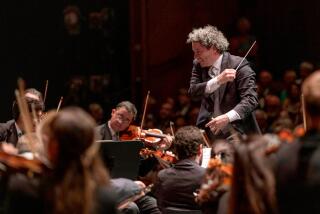Cast tops 1,000 for Mahler’s ‘Symphony of a Thousand’ in L.A.
How many performers does it take to pull off Gustav Mahler’s Symphony No. 8, popularly and dauntingly known as the “Symphony of a Thousand”? The answer isn’t as obvious as it appears.
For the Los Angeles Philharmonic, which performs the gargantuan symphony Saturday at the Shrine Auditorium, the tally is 1,011, with a lingering asterisk or two. It marks a rare, but certainly not unique, instance of the symphony being performed on the scale that the composer intended.
The bulging roll call consists of 18 different groups coming together for an unprecedented undertaking by the orchestra: 91 musicians from the L.A Philharmonic, 99 from the Simón Bolívar Symphony Orchestra of Venezuela, 813 singers from 16 local choruses and eight vocal soloists.
Add to that figure one curly haired conductor named Gustavo Dudamel, who will be leading the piece for the first time in his career. The concert is the culmination of the orchestra’s Mahler symphony cycle that has been unfolding since January and continues this month in Venezuela.
The figures, obtained by polling the participating groups, were still fluctuating slightly at the time this story went to press, but the final count is expected to be close. The youngest singer is 9 years old while the oldest are believed to be in their 70s, but not all groups were able to provide age details.
Saturday’s concert is the largest production ever mounted by the L.A. Philharmonic. The concert is so big that the orchestra had to rent out the Shrine and nearly double the size of the already massive auditorium’s stage — including installing 18 levels of risers — to accommodate all of the performers.
Most concerts of the Eighth feature 500 or fewer performers as a practical matter, according to Henry-Louis de La Grange, one of the world’s foremost experts on Mahler.
“It’s most exceptional when there are more than 1,000,” he said in a phone interview from Switzerland.
The symphony — whose scale puts it in the same league as Beethoven’s Symphony No. 9 and Britten’s War Requiem — holds symbolic value for orchestras.
“It’s a hymn of glory, to eternity. It’s very mystical of course, as Mahler was,” said La Grange. “So many Mahlerians don’t like it — they can’t accept the fact that he was optimistic.”
The Shrine’s audience capacity on Saturday will be about 5,400 seats, with several rows taken out of the orchestra section to accommodate the enlarged stage, according to the orchestra. That’s still nearly double the capacity of Walt Disney Concert Hall’s 2,265 seats. The orchestra is installing two large video screens on the wings of the auditorium to give audiences in the back a view of the stage.
The concert has been sold out for several weeks, but scalpers are hawking tickets online. One site was offering orchestra seat tickets for $700 each.
In the context of the symphony’s history, Saturday’s performance probably won’t be a record breaker.
The Munich, Germany, world premiere in 1910, conducted by Mahler himself, featured a slightly larger head count. Estimates of that historic debut vary, with most putting the number around 1,020. (Mahler was said to detest the focus on statistics. He also disliked the symphony’s nickname, which was concocted by a promoter.)
Last year, a concert of the Eighth at the Ljubljana Summer Festival in Slovenia reportedly had more than 1,100 performers.
The last time the L.A. Philharmonic performed the symphony was in 2008 at the Hollywood Bowl, conducted by Esa-Pekka Salonen. That concert featured about 300 musicians and singers.
The San Francisco Symphony won three Grammy Awards for its recording of the piece in 2009. The recording featured a roster of 386 performers, according to the orchestra.
Rehearsing for Saturday’s concert has been a complicated affair. Choral groups — some professional, some amateur — started rehearsing independently in the summer and have put in more than 165 hours combined. A recent rehearsal of all the choral groups was so large that the singers had to take over the seats in Disney Hall while Dudamel conducted from the stage.
“I think the most important thing is to focus the sound,” Dudamel told the singers, adding that the entire chorus should sound like “a small group with a lot of power.”
One area of difficulty for such a large ensemble is the proper articulation of the text — Latin in the symphony’s first half, and German in the second section inspired by Goethe’s “Faust.” “We are rushing because we are not taking the time to say everything,” the conductor said during the rehearsal.
The Los Angeles Master Chorale has the largest contingent in the concert, with 108 professional singers expected to participate. The Los Angeles Children’s Chorus will be represented with 52 singers. Other choral groups taking part include the Los Robles Master Chorale, the Pacific Chorale, the Gay Men’s Chorus of L.A. and the Philippine Chamber Singers.
Grant Gershon, the head of the L.A. Master Chorale, is serving as the chorus director. He met with all of the choir directors in June and spent hours going through the piece measure by measure. He also made an annotated score and sample audio files available for download via an extranet.
The Symphony No. 8 clocks in at about 1 hour and 30 minutes. It isn’t the longest of Mahler’s symphonies, which would be the Third, at about 1 hour and 40 minutes.
Singers involved in Saturday’s concert described the piece as demanding but not extraordinarily difficult.
“I think Dudamel has the hardest part,” said Nicole Baker, a member of the L.A. Master Chorale. “It’s the difference between driving a small car and a huge bus. There’s a lot of potential for things to fall apart.”
Jamal Jaffer, a seventh-grader at Polytechnic School in Pasadena and a singer with the L.A. Children’s Chorus, said the acoustics of the Shrine could be challenging. “I’m pretty nervous about not hearing the people around me, but I’m excited to be with that many people,” he said.
The L.A. Philharmonic has only three rehearsals at the Shrine before the concert, including one on Saturday morning.
One reason the symphony rarely is performed on such a large scale is the simple factor of economics. Engaging a chorus numbering in the several hundreds can be prohibitively expensive. The L.A. Philharmonic is solving this problem by relying partly on amateur choral organizations. Choral groups said they are receiving a small honorarium of about a couple thousand dollars each.
A spokeswoman for the L.A. Master Chorale said the group is receiving a standard fee based on a negotiated rate with the musicians’ union.
Deborah Borda, president of the L.A. Philharmonic, said the orchestra’s decision to go big was an artistic choice and a reference to the 1910 world premiere. In an e-mail, Borda said that “Gustavo wished to honor that initial performance and the composer’s own conception of the work.”
More to Read
The biggest entertainment stories
Get our big stories about Hollywood, film, television, music, arts, culture and more right in your inbox as soon as they publish.
You may occasionally receive promotional content from the Los Angeles Times.











